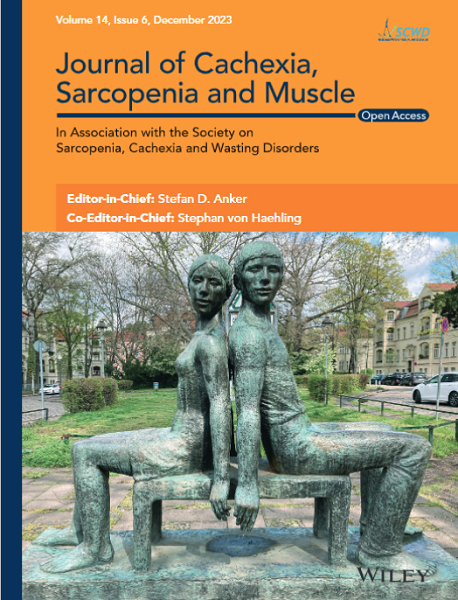Plasma Extracellular Vesicles Biomarkers Linked to Lower Muscle Mass, Function and Physical Performance in Sarcopenia
Abstract
Background
As society ages, identifying individuals at risk of sarcopenia becomes essential. Several plasma biomarkers are used to assess musculoskeletal status, but their results are inconsistent. Extracellular vesicles (EVs) are investigated as disease biomarkers due to their role in transporting molecules and influencing cellular processes. This study investigated the correlation of known sarcopenia biomarkers—adiponectin, myostatin, P3NP, CRP and TNF-α—measured from plasma-derived EVs with muscle mass, function and performance in an Osteoporosis Sarcopenia cohort at the Seoul National University Bundang Hospital.
Methods
Muscle mass was evaluated by measuring appendicular skeletal muscle mass (ASM) using dual X-ray absorptiometry and calculated as ASM/height2. Hand grip strength was measured using a hydraulic hand dynamometer for muscle function and physical performance based on the Short Physical Performance Battery (SPPB), walking speed and the five-time-sit-to-stand test. Density gradient ultracentrifugation was used to isolate EVs from the plasma, followed by confirming the expression of sarcopenia biomarkers. Multivariate regression analysis, adjusted for sex, age, body mass index, smoking, drinking, and bone density, was performed.
Results
The mean age of participants was 74.3 ± 12.1 years (range, 52.0–96.0), with 88.2% being female. Plasma-derived EV levels of myostatin and P3NP were significantly associated with walking speed (ꞵ = −0.309, p = 0.014) and SPPB (ꞵ = −0.276, p = 0.029), respectively. TNF-α levels were strongly correlated with hand grip strength (ꞵ = −0.313, p = 0.013). Using receiver-operating characteristic curve analysis, cutoff values for three factors were determined, allowing participants to be categorized into high and low groups. Low myostatin group had a higher hand grip strength (19.63 kg vs. 17.14 kg, p = 0.027) and faster five-time-sit-to-stand test times (17.34 s vs. 23.72 s, p = 0.032). Low P3NP levels showed a stronger grip strength (19.87 kg vs. 16.81 kg, p = 0.008), better SPPB scores (9.10 vs. 8.03, p = 0.006) and five-time-sit-to-stand times (18.31 s vs. 21.87 s, p = 0.002). Low TNF-α levels were linked to better walking speeds (0.82 m/s vs. 0.64 m/s, p = 0.009) and lower SARC-F scores (1.73 vs. 3.26, p = 0.029).
Conclusion
Our research confirmed that EVs-derived myostatin, P3NP and TNF-α are strongly associated with muscle function and performance. Significant differences in these factors between high and low groups based on biomarker cutoffs emphasize their diagnostic relevance for sarcopenia. These findings offer a promising avenue for identifying effective markers in future research and clinical applications.


 求助内容:
求助内容: 应助结果提醒方式:
应助结果提醒方式:


